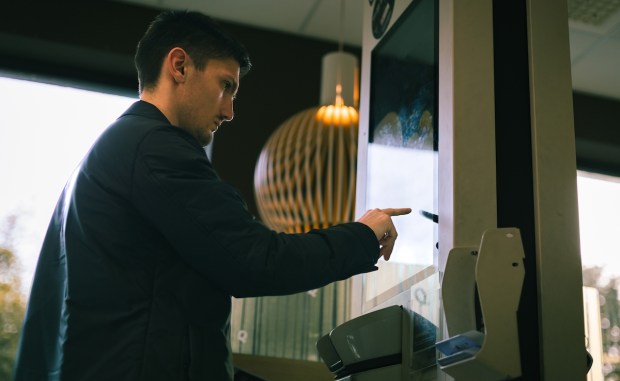
As own-device self-service catches on across industries, restaurants are leveraging kiosks to reach consumers who have not adopted mobile payments, according to GoTab.
The restaurant technology provider’s CEO Tim McLaughlin told PYMNTS in an interview, following the launch of the company’s Self-Ordering Kiosks last week, that the technology enables food service venues to offer self-service for consumers who are not as comfortable with mobile technology.
“It’s all about reducing friction,” McLaughlin said. “Payments are a particular point of friction because a lot of people don’t have digital cards or digital wallets provisioned. So, they’re using a physical card. That’s, candidly, the biggest reason for our kiosks. … The kiosk is really addressing the gap of people who aren’t comfortable doing things on their phone.”
PYMNTS Intelligence found that most consumers do not use mobile wallets to pay for purchases. The report “The Mobile Wallet Challenge: Replacing Physical With Digital,” a PYMNTS and ACI Worldwide collaboration, which drew from a survey of more than 2,000 U.S. consumers, revealed that 27% of respondents had used a mobile wallet to pay merchants with QR codes or near-field communication (NFC) tap to pay. That means more than three-quarters did not.
McLaughlin said these kiosks remain a “transitional technology,” where the larger screen provides certain benefits, but the overall trend is nonetheless toward own-device self-service.
GoTab’s self-service devices are somewhat different than the typical restaurant kiosk experience because rather than simply powering one-time ordering and payment, they enable consumers to keep tabs open and split tabs with others.
“Self-service is popular in places where time is really critical, and it’s not necessarily a place to consider experiential,” McLaughlin said.
PYMNTS Intelligence revealed that restaurant customers feel differently about self-service technology depending on the situation. According to the report “The Digital Divide: Technology, the Metaverse and the Future of Dining Out,” which drew from a survey of about 2,500 U.S. consumers, 51% of grab-and-go restaurant customers said ordering through a self-service kiosk would positively impact their satisfaction, while 20% of dine-in customers said the same.
Restaurants, for their part, are looking for technologies that will reduce their labor needs as margins remain pressured. Research cited in the PYMNTS report “Inflation Puts Technology on the Menu for Restaurants,” the June edition of the “B2B and Digital Payments Tracker®,” created in collaboration with American Express, revealed that 76% of restaurants use automation in at least three areas of operations.
Overall, kiosks represent a relatively small portion of all restaurant orders. A PYMNTS survey of more than 2,200 U.S. consumers last year revealed that 7% of diners’ most recent orders were placed in person through an automated kiosk.
Looking ahead, McLaughlin said he expects self-service technology to continue to grow in the restaurant industry, taking over the parts of the dining process that have typically relied on the labor of servers without adding much to consumers’ process.
“I think self-service will eliminate all of the un-fun parts of the experience,” he said. “So, checking in, … reordering. Ordering the first time is oftentimes fun. Reordering is not terribly fun. … Each of these different modes of interaction has its strengths and weaknesses, and I would say overall, anything that is transactional and not experiential will be moved to self-service.”